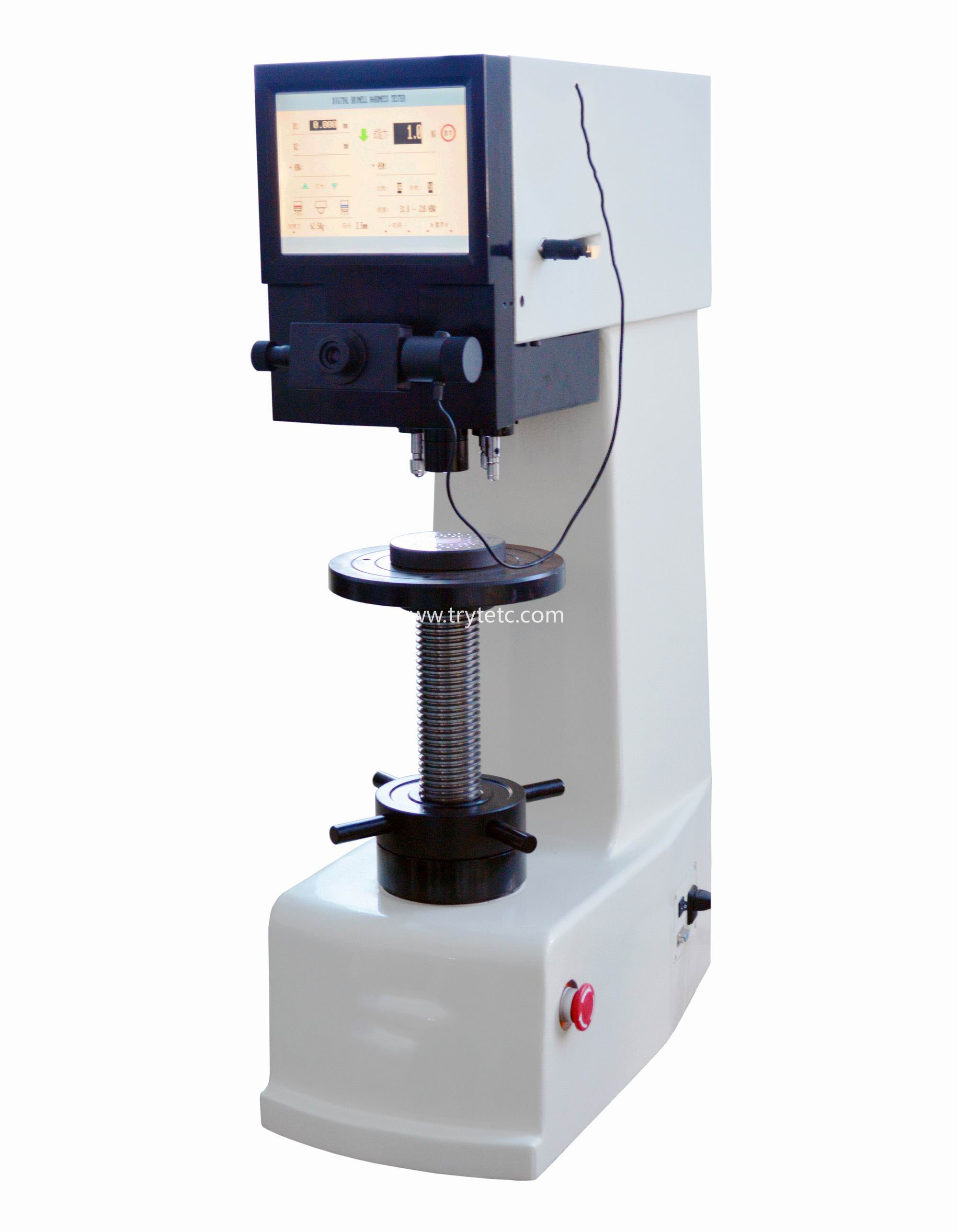
1. Hardness is one of the important indices of material mechanical performance. And hardness test is the important means to determine metal material or the quality of product parts. Because of the corresponding relation between metal hardness and other mechanical performance, therefore, most metal materials can be measured the hardness to approximately calculate the other mechanical performance, such as strength, fatigue, creep and wear. Brinell hardness test can satisfy the determination of all the metal material hardness by using different test forces or changing different ball indenters.
2. The instrument adopts precise structure design and the load of test force is controlled by the sensor. It makes the whole structure compact and loading of test force stable and exact. The test process is controlled by CPU, using automatic switching between the objective and the indenter. The location of switching adopts mechanical and electronic double matching, makes the location precision more high. Select the scale to start, the instrument will choose the corresponding indenter and objective to realize the automatic measurement. On the basis of the last generation, this instrument adopts touching screen, makes the parameters set and the results show more intuitive, and the operation is more convenient.
3. The instrument can apply to the measurement of cast iron, nonferrous metal and alloy material, various annealing, hardening and tempering steel, especially the soft metal such as aluminum, lead, tin etc. which makes the hardness value more correct. The main function is as follows:
This instrument has 10 level of test force, 13 Brinell hardness test scales, free to choose;
With two objectives, both can beinvolved in the measurement of indentation length;
With three indenters for automatic measurement;
Automatic switching between the objective and the indenter;
Can preset the test force dwell time and adjust intensity of light source;
Can show the indentation length, the hardness value and the number of measurements etc.;
Choice of conversion between each scale of hardness values;
The test result can be printed;
According to the particular requirements of the client, it can be equipped with CCD indentation automatic measuring device or video measuring device.
Technical Specifications:
1. Test force:
Totally 10 level of test force:
612.9N’╝ł62.5kg’╝ē | 4903N’╝ł500kg’╝ē |
980.7N’╝ł100kg’╝ē | 7355N’╝ł750kg’╝ē |
1226N’╝ł125kg’╝ē | 9807N’╝ł1000kg’╝ē |
1839N’╝ł187.5kg’╝ē | 14710N’╝ł1500kg’╝ē |
2452N’╝ł250kg’╝ē | 29420N’╝ł3000kg’╝ē |
Test force control: closed loop system
Test force applying: automatic (loading / dwell/ unloading)
Applying time of test force: 2~8s
Dwell time: 0~60s (5 seconds as an unit)
2. Specification of the indenter
Žå2.5mmball indenter
Žå5mmball indenter
Žå10mmball indenter
3. Brinell hardness test scale
Totally 13 test scales
Diameter of Indenter | Brinell Hardness Scale |
10mm | HBW 10/3000 | HBW 10/1500 | HBW 10/1000 | HBW 10/500 |
HBW 10/250 | HBW 10/125 | HBW 10/100 |
|
5mm | HBW 5/750 | HBW 5/250 | HBW 5/125 | HBW5/62.5 |
2.5mm | HBW 2.5/187.5 | HBW2.5/62.5 |
|
|
4. Repetition and tolerance of displayed value for the hardness tester
Standard hardness test block (HBW) | Tolerance of displayed value% | Repetition of displayed value% |
Ōēż125 | ┬▒3 | 3 |
125’╝£HBWŌēż125 | ┬▒2.5 | 2.5 |
’╝×225 | ┬▒2 | 2 |
5. Optical system
Eyepiece | Objective | Total Amplifications | Resolution |
20ŌĢ│ | 1ŌĢ│ | 20ŌĢ│ | 1.25╬╝m |
2ŌĢ│ | 40ŌĢ│ | 0.625╬╝m |
6. Test force carried: Automatic (loading/dwell/unloading)
7. Shifting between the indenter and objective: Automatic
8. Hardness reading: Measure the length of indentation, press the button to input, it automatically calculate and show the hardness value.
9. Scale conversion: Choice of conversion between each scale of hardness values.
10. Appearance parameters:
Overall dimensions (H├ŚD├ŚW): (890├Ś535├Ś260) mm
Maximum height of specimen allowed: 260 mm
Distance between the point of the indenter and the exterior panel: 150 mm
Weight: 160 kg
Power and voltage: AC 220V/110V┬▒5%’╝ī50~60 Hz
Technical Specifications:
1. Test force:
Totally 10 level of test force:
612.9N’╝ł62.5kg’╝ē | 4903N’╝ł500kg’╝ē |
980.7N’╝ł100kg’╝ē | 7355N’╝ł750kg’╝ē |
1226N’╝ł125kg’╝ē | 9807N’╝ł1000kg’╝ē |
1839N’╝ł187.5kg’╝ē | 14710N’╝ł1500kg’╝ē |
2452N’╝ł250kg’╝ē | 29420N’╝ł3000kg’╝ē |
Test force control: closed loop system
Test force applying: automatic (loading / dwell/ unloading)
Applying time of test force: 2~8s
Dwell time: 0~60s (5 seconds as an unit)
2. Specification of the indenter
Žå2.5mmball indenter
Žå5mmball indenter
Žå10mmball indenter
3. Brinell hardness test scale
Totally 13 test scales
Diameter of Indenter | Brinell Hardness Scale |
10mm | HBW 10/3000 | HBW 10/1500 | HBW 10/1000 | HBW 10/500 |
HBW 10/250 | HBW 10/125 | HBW 10/100 |
|
5mm | HBW 5/750 | HBW 5/250 | HBW 5/125 | HBW5/62.5 |
2.5mm | HBW 2.5/187.5 | HBW2.5/62.5 |
|
|
4. Repetition and tolerance of displayed value for the hardness tester
Standard hardness test block (HBW) | Tolerance of displayed value% | Repetition of displayed value% |
Ōēż125 | ┬▒3 | 3 |
125’╝£HBWŌēż125 | ┬▒2.5 | 2.5 |
’╝×225 | ┬▒2 | 2 |
5. Optical system
Eyepiece | Objective | Total Amplifications | Resolution |
20ŌĢ│ | 1ŌĢ│ | 20ŌĢ│ | 1.25╬╝m |
2ŌĢ│ | 40ŌĢ│ | 0.625╬╝m |
6. Test force carried: Automatic (loading/dwell/unloading)
7. Shifting between the indenter and objective: Automatic
8. Hardness reading: Measure the length of indentation, press the button to input, it automatically calculate and show the hardness value.
9. Scale conversion: Choice of conversion between each scale of hardness values.
10. Appearance parameters:
Overall dimensions (H├ŚD├ŚW): (890├Ś535├Ś260) mm
Maximum height of specimen allowed: 260 mm
Distance between the point of the indenter and the exterior panel: 150 mm
Weight: 160 kg
Power and voltage: AC 220V/110V┬▒5%’╝ī50~60 Hz

